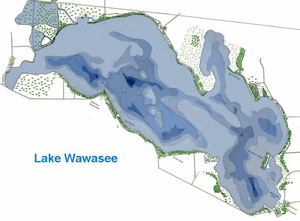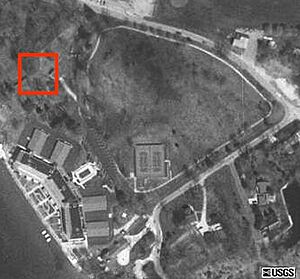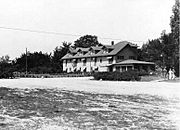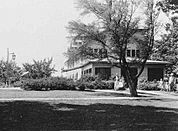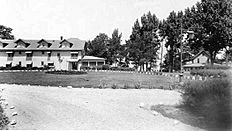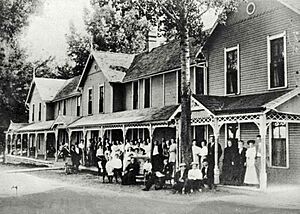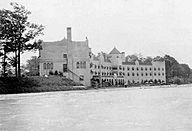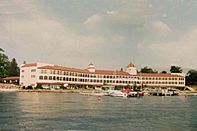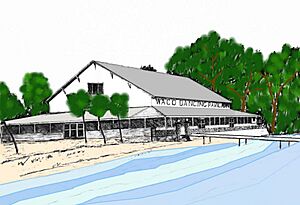History of Lake Wawasee facts for kids
Lake Wawasee is a big, natural freshwater lake located southeast of Syracuse in Kosciusko County, Indiana. It's the largest natural lake in all of Indiana.
Contents
How Lake Wawasee Was Formed
The Ancient Teays River
About a million years ago, long before the Ice Age, northern Indiana was covered by the huge Teays River system. This river flowed from Virginia, West Virginia, and Ohio. It entered Indiana in Adams County and flowed about 45 miles (72 km) south of where Lake Wawasee is today.
After the Ice Age
After the last big Ice Age, the land was left with many holes and hills. These holes are called kettle holes, and the hills are called moraines. The area was first covered by huge evergreen forests, like spruce and balsam poplar trees. Later, tougher trees like oak, poplar, and hickory grew there.
Many amazing animals lived here, including saber-toothed cats, American mastodons, short-faced bears, dire wolves, ground sloths, giant beavers, peccaries, stag-moose, and ancient bison. The lakes were home to large fish like sturgeon, whitefish, pike, pickerel, and muskellunge. Smaller fish like bluegill, redear sunfish, black bass, yellow perch, and catfish also swam in these waters.
Long ago, Lake Wawasee was about 7 to 8 feet (2.1 to 2.4 meters) deeper than it is now. This is known from old beach lines and peat beds. Water flowing out of the lake slowly lowered its level by 6 to 7 feet (1.8 to 2.1 meters). However, a dam built in 1834 brought the lake level back up to where it is today.
Early History of Lake Wawasee
The 1800s and Native Americans
Before Europeans arrived, the land around Turkey Lake (which is now Lake Wawasee) belonged to the Miami Indian tribe. Two important chiefs were Wawasee and Papakeecha. Chief Wawasee signed the Treaty of Mississinewas. In 1828, he was given a small village area about two and a half miles southeast of Milford. This area included the eastern shores of Turkey Lake. His brother received the southern half of the lake.
The first European settlers were homesteaders. They made a living by hunting, fishing, and trapping, with a little farming. White settlers started coming to the area in the early 1830s and called the lake "Turkey Lake." In 1834, the U.S. government gave the land to the Wabash and Erie Canal company. This company sold it to Charles R. Ogden in 1875, and then "Uncle" Billy Moore bought it in 1877.
Important Places Around Wawasee
Cedar Point
Cedar Point is on the eastern side of Lake Wawasee. It's a hill formed by a glacial stream during the Ice Age. This area was home to the Glacial Kame Culture people from 8000 BC to 1000 BC. They traded with tribes in the southern United States, as shown by shells from the Gulf of Mexico found here. These shells were shaped like shoe soles or circular disks and worn as necklaces.
In the 1880s, human bones were found sticking out of rocks. Later, during construction, more artifacts and bones were discovered. In the 1870s or 1880s, a single person lived alone at Cedar Point. In the 1940s and 1950s, ancient fireplaces made of burned stones were found on top of Cedar Point. This area is the most proven site of Paleoindians living along Wawasee's shore. In the early 1900s, the ground was leveled for construction, changing its natural look. Today, many summer and year-round homes are located there.
Conkling Hill
Conkling Hill is named after William Conkling, an early settler who arrived in the 1830s. He might have been a sailor during the War of 1812. In 1844, a visitor described Conkling's small cabin with one bed. In 1894, a church group bought Conkling Hill and named it Oakwood Park. Today, it's a 42-acre (170,000 m²) religious retreat called Oakwood Foundation.
Morrison's Island
Morrison's Island was first called Eagle Island by early white settlers because bald eagles nested there. It was also covered with many different kinds of trees. The island is on the south-southeast end of Wawasee, looking over Buttermilk Bay and Johnson's Bay. It was named after William T. Morrison, a Civil War soldier who fought for the Union army. Morrison moved to the area and taught at an old schoolhouse.
Morrison built a cabin on Eagle Island where he and his family lived until the 1890s. His house later burned down. A story says he used the insurance money to buy a new shotgun and a melodeon (a type of organ) and moved into his barn. In the 1900s, Morrison sold his island property for a good amount of money. He moved to Oregon but soon returned to Indiana, living comfortably in Ligonier with his pension and the money from the sale. Elwood George later developed the island.
Kale Island
In 1862 or 1863, two brothers, Thomas and Kale Oram, settled on Kale Island. They caught fish with nets to sell in Goshen and cleared about 20 acres (81,000 m²) of land. They floated trees through the main channel to sawmills. Poplar trees were used for homes in Syracuse, and oak trees were made into barrels and firewood. The Oram brothers planted Concord and Delaware grapes. During the Civil War, Thomas Oram joined the Union army and later moved to Kansas. Kale married a woman named "Mam," who lived with her son Bill in a small cabin on Syracuse Lake. They lived on Kale Island until 1874.
In 1873 or 1874, John Wysong and March McCory built Island House on Kale Island. This was Lake Wawasee's first summer hotel. It wasn't built very well and became a place for poker games and drinking. It eventually burned down. George W. Miles later bought Kale Island and developed it into a fancy area for homes.
Dog Creek Dam
Dog Creek Dam and a "fish trap" were located just north of E. Pickwick Drive on Kale Island. This dam continued south towards Oakwood Park. The north and west sides of the dam formed the "fish trap," which would flood in the spring. As the water went down, local settlers could easily catch fish with nets and pitchforks.
The outlet between Lake Wawasee and Syracuse Lake was a perfect spot for a grist mill (a mill for grinding grain). A millrace (a channel for water to power a mill) was built there. The first mill was constructed in 1834 by Sam Crosson and Henry Ward. It was quickly destroyed, either by spring floods or by sinking into a soft, muddy area. Two large mill stones from this mill can still be seen on the north side of Kale Island.
Famous Places and Hotels on Wawasee
Cedar Beach Club
The Cedar Beach Club was started in 1880. It was the first hotel on this spot. The North Lake and River Association bought the property. Judge John V. Pettit became president of the association. Members came from towns like Alexandria, Goshen, Peru, Wabash, and Huntington. They were all followers of Izaac Walton, which later led to the Izaak Walton League, an early environmental group.
They built a simple, two-story club house with a gabled roof. It had 50 bedrooms and a dining room that could seat 125 people. The North Lake and River Association ran into financial trouble in 1882, and the property was sold to the Cedar Beach Association. In 1887, it was transferred to the Cedar Beach Club for $7,000. In 1891, the club burned down. It had the first seawall on Wawasee, made of logs.
The Jones Hotel
The Jones Hotel opened in September 1881 on the north shore of the lake. It was the first major place for entertainment on Turkey Lake. Abram M. Jones, a former mechanical engineer for the B&O Railroad, built it. He and his family moved to Syracuse in 1875. Jones also ran the Syracuse grain elevator.
The Jones Hotel was very successful. It served great meals, and the rooms were comfortable. Many of Wawasee's early boats and yachts were built in the barn behind the hotel. In 1920, Mr. M. E. Crow bought the Jones Hotel.
Sargent's Hotel
Sargent's Hotel was built in the early 1900s by Mr. J. (Jess) M. Sargent. It was on the northeast shore of the lake, next to the Spink's Wawasee Hotel and south of the Lilly homes.
Jess Sargent came to Wawasee in 1899 and helped fix a sailboat. He later opened a boat repair and rental business, which grew quickly. The Sargents started renting rooms to visitors. They bought more land, and soon built the hotel. Sargent's Hotel hosted many dinner parties for large groups. It was torn down in 1957.
Buttermilk Point
Buttermilk Point was a resort hotel at the very south end of the lake, on the south shore of Buttermilk Bay. Lewis Jarrett, a Civil War veteran, owned it. In 1893, his wife Elizabeth became the owner. Early on, a log milkhouse was built near a spring. It sold buttermilk, sweet cream, and butter to passengers on passing steamboats. This site later became the Johnson Hotel, then was sold to the Hilburt family. The Johnson Hotel, one of the last big old hotels, was sold at auction in 1971.
The Crow's Nest
The Crow's Nest is on Wawasee's east-southeast shore. Nathaniel N. Crow, an early farmer, built it. He was born in Champaign County, Ohio, in 1823. In 1845, he came to Kosciusko County. Nathaniel bought 80 acres (320,000 m²) of land for $20 and sold his horse. He later sold this land for a profit and bought a farm in Turkey Creek Township. His first home was built closer to what became known as Natti Crow Beach.
Nathaniel married Eliza Airgood in 1852. They started their life on the farm. By farming carefully, their farm grew to 550 acres (2.2 km²) of land. The Crow's Nest had a blacksmith's shop that used a spring to power a hydraulic ram. The remains of the spring and ram were still there in the 1960s.
In the 1950s, the farm became the Crow's Nest. The Crow house and huge barn became the Crow's Nest Yacht Club in 1959. The barn was turned into a boat storage building, able to hold many boats on 2-3 levels. Natti Crow Beach is one of Wawasee's true sand beaches, extending up to 20 feet (6.1 meters) from homes to the water's edge. It runs about 1,200 feet (370 meters) north to south. The homes in this area are part of the Natti Crow Beach Association. The wetlands near the Crow's Nest are called the WACF Nathanial Crow Wetlands.
Vawter Park
Vawter Park Village was planned in 1887. The Vawter Park Hotel was built around 1888, followed by cottages near the hotel. The hotel was said to be built and furnished in a fancy Victorian era style. Important people like Ovid Butler of Indianapolis settled in this area. In 1918 or 1919, the Vawter Park Hotel burned down. Around 1920, a new hotel was built on the same spot, but it also burned down between 1920 and 1925. The South Shore Inn later took its place. Indiana University also had a laboratory here for some time.
South Shore Inn
The South Shore Inn was a hotel built where the old Vawter Park Hotel used to be. In the 1950s and early 1960s, the hotel attracted visitors with a water ski jump show. The South Shore Inn caught fire early in the morning on October 29, 1964.
Wawasee Inn
The first Wawasee Inn was built in 1892 by Colonel Eli Lilly and his friends on the site of the Cedar Beach Club. Lilly died in 1899, and the building was sold. In the autumn of 1918, it was destroyed by fire.
Wawasee Inn (Second)
The second Wawasee Inn was not on the north shore like the first one. It was formerly the Tavern Hotel, a two-story building with 26 rooms built in 1926 on the south shore of Lake Wawasee. On April 18, 1955, the inn was badly damaged by fire.
Spink Wawasee Hotel
The Spink Wawasee Hotel was built by the Spink family of Indianapolis in 1925. It was built on the site of the first Wawasee Inn Cedar Beach Club. After the Spink family members passed away, the hotel was sold to the Crosier Order of the Roman Catholic Church. After a lot of remodeling, it opened on August 15, 1948, as Our Lady of the Lake Seminary. It had 118 students.
In June 1950, work began on a gym. From 1952 to 1953, a library was completed. In the winter of 1954, an auditorium was built. In 1965, the seminary was bought and renamed Wawasee Preparatory. It became a coeducational school (for both boys and girls) in the 1970s. Wawasee Prep closed in the summer of 1975. Today, this former hotel, seminary, and prep school is a fancy condominium building.
Waco Entertainment Hall
Waco (Wawasee Amusement Company) was a large entertainment hall built around 1910. It was first planned as a floating building but was built on land instead. It was located in the Lakeview-South Park area. Since the land was low, sand was pumped in from the lake bottom to raise it. There were no sleeping rooms for the performers and orchestras, so they used tents in the summer. In 1923, Waco was made bigger.
Managed by Ross Franklin, Waco became nationally famous. It hosted many talented artists like Hoagy Carmichael, Glenn Miller, Guy Lombardo, Tony Bennett, Ted Weems, Duke Ellington, Spike Jones, Wayne King, and Jan Garber. After Ross Franklin left, Waco became a roller skating rink. In the 1960s, it became a lakeside restaurant with a dock and sometimes had live entertainment. Waco was torn down in the 1970s.
Wawasee Yacht Club
The Wawasee Yacht Club was started in 1935. Four people who loved Snipe sailboats visited Wawasee to see if it was a good lake for sailing. They used the front porch of Bishop's Boat Livery and Marine Supply as their first meeting place and dock. Today, the club sails 28-foot (8.5-meter) E-Scows, 19-foot (5.8-meter) Lightnings, and 13-foot (4.0-meter) Sunfish class boats. They hold three regattas (sailing races) from June through early October.
Angler's Cove
Angler's Cove was a surf and turf restaurant and bar located on N. Ogden Park Road, Ogden Island. It was popular with boaters from the late 1950s through the 1970s. You could reach it from the channel on the west side of Johnson's Bay.
A&W Root Beer Stand
From the 1950s to the early 1980s, Jack's A&W Root Beer Stand was a popular spot. It was on E. Pickwick Drive, next to the bridge over the main channel. You could get to this root beer stand by boat or car. It served typical hamburger stand food. At that time, only the A&W, Angler's Cove, and Waco offered food that you could get by boat. The A&W is now The Channel Marker Restaurant.
Boating on Wawasee
Early Boats on Wawasee
Steamboats
- The Anna Jones was a steam tug (a boat powered by steam). It was named after Abram B. Jones' daughter. It was bought in Chicago in the mid-1880s and brought to Wawasee by train. It was then cut in half, and a middle section was added, making it about 40–45 feet (12–14 meters) long.
- The Anna Jones II was a 76-foot (23-meter) steam yacht bought by Abram Jones about six years after the first Anna Jones. It could hold 100 people and was the largest boat to ever sail on Turkey Lake.
- The Gazelle, brought to Wawasee in 1885, was another steam-powered yacht. It was about 70 feet (21 meters) long and had a screw propeller but no sails.
Sailboats
- The Anita was a 20-foot (6.1-meter) sloop (a type of sailboat) built by Higgins & Gifford and owned by Walter Nordyke.
- The La Cigale and its sister boat Margaret were designed by Dr. Harry S. Hicks. They were built in the barn behind the Jones Hotel. They were the first flat-bottomed scows on Turkey Lake.
- The Keflin, the lake's first fin keel sailing yacht, was also built behind the Jones Hotel. It had a unique torpedo-shaped ballast (weight to keep it stable) of several hundred pounds at the end of its keel. People said it was impossible to flip over the Keflin.
- The Mary Louise was a large sail cabin yacht with the biggest sail area of any boat on the lake.
- The Eleanor was an 18-foot (5.5-meter) catboat owned by H.S. Tucker.
- The Cynthia was a 20-foot (6.1-meter) sloop with 647 square feet (60.1 m²) of sails and 1 ton of ballast. It was owned by Colonel Eli Lilly.
- The Emanon and Leirion were A-Scows built in the early 1900s. These two boats raced in the 1901 Inland Lake Yachting Association races in Green Lake, Wisconsin.
Important Events at Wawasee
The Plan to Drain Wawasee
In the late 1880s, some farmers who owned swampland around Wawasee tried to take control of the dam at Syracuse. Their goal was to destroy it to make their land bigger. However, the B&O Railroad and the Cedar Beach Club stopped the farmers in the Indiana Supreme Court. In 1883, B.F. Crow, who owned the dam and 27 acres (110,000 m²) of land, died.
A new dam was suggested near Oakwood Park or further north on the main channel. To make sure the dam was protected, Colonel Eli Lilly bought the property for $3,000. In 1895, the Syracuse Water Power Company was created. Its owners included the B&O Railroad and wealthy cottage owners.
Sturgeon in Wawasee
Sturgeon are rare, ancient, and hard-to-find fish. They have been caught in Wawasee sometimes. The first known catch was around 1855, when Jake Renfro and three others speared a sturgeon in the main channel between Syracuse Lake and Wawawsee. In the 1870s, Jim Jones, a steamboat pilot, saw a sturgeon while ice fishing. The most recent account was in 1991, when a sturgeon estimated to be over 90 pounds (41 kg) was caught and released by a local fisherman, David Riddle. Sturgeon are an endangered species, which means they are protected by law.
The Great Wawasee Storm of 1943
On Wednesday, July 21, 1943, a huge thunderstorm formed over southwest Michigan and quickly moved southeast. At 6:05 pm, the storm hit Elkhart, tearing trees from the ground and knocking down power lines. By 6:10 pm, the storm had traveled 10 miles (16 km) to Goshen. In New Paris, two 80-foot (24-meter) smokestacks, each weighing 4 short tons (3,600 kg), were destroyed.
At 6:30 pm, trees were falling in Syracuse. Within minutes, waves on Wawasee were 6 feet (1.8 meters) high, with heavy rain and hail. Six boaters on Wawasee lost their lives: Sergeant Lloyd Burkholder (25), Dean Yoder (21), Lloyd Conklin (21), Dorothy Beckerich (21), Billie Binkley (20), and Virginia Rush (20).
Images for kids


